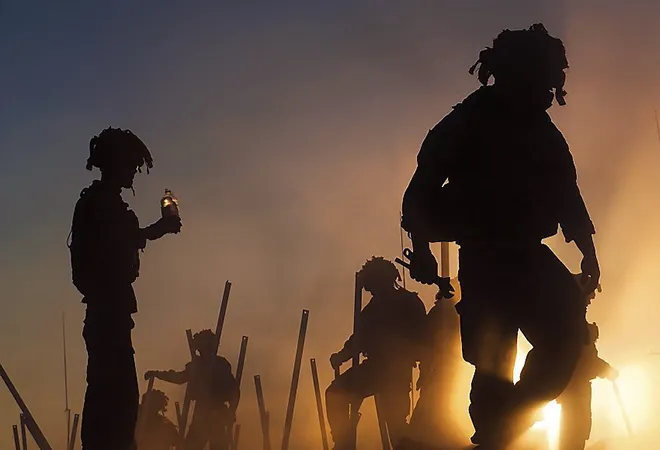The recent India–Myanmar Bilateral Army Exercise reflects the growing defence relationship between the two neighbours. While such exercises are routinely used to deepen military-to-military ties, the nature of November’s military exercise is distinctly relevant to Myanmar’s current challenges.
This joint exercise was aimed at a specific type of training: United Nations peacekeeping operations. This may seem ironic, as Myanmar and its armed forces are under heavy international criticism over alleged atrocities against and violations of the human rights of Rohingya Muslims in Myanmar’s northern Rakhine State. This persecution has pushed several hundred thousand Rohingyas into neighbouring Bangladesh. The Tatmadaw (Myanmar’s armed forces) has long been denounced both within and outside the country for the abuse it directs at and the oppressive tactics it employs against its minority communities. The recent crackdown in Rakhine State following terror attacks are characterised by the United Nations as ‘ethnic cleansing’.
Demands are mounting to deploy UN peacekeepers to protect the Rohingya community within Myanmar. An ongoing debate rages on whether Myanmar should even be able to contribute to UN peacekeeping operations in light of its poor record on human rights and civilian protection.
Engaging the Myanmar Army in exercises such as those with India provides an opportunity for Myanmar Army officers to learn from the experiences of other armed forces in international military operations. The latest exercise is part of a series of training exchange programmes extended to the Myanmar Army that focus on UN peacekeeping, including ‘humanitarian relief operations, rebuilding infrastructure, providing civilian police support, monitoring borders and supporting electoral processes.’ The week-long joint exercise trained 15 officers of the Myanmar Army to meet the evolving challenges of peacekeeping operations in accordance with the ‘principles, policies and guidelines’ of the United Nations. It will substantially enhance the Myanmar Army’s experience of conducting international military operations in conflict situations.
UN peacekeeping training operations between the Indian and Myanmar armies are typically series of training exchange programmes. The last exercise in this series was held in early August in Myanmar’s capital Naypyidaw and trained 30 Myanmar officers. The Indian Army has agreed to train the Myanmar Army every year for a total of five years through its mobile training teams. Until recently, the mobile training teams sent to Myanmar largely focused on naval training administered by the Indian Navy.
Since India is the world’s third-highest contributor to UN peacekeeping forces and has a long history of participation in UN peacekeeping, the Centre for United Nations Peacekeeping in New Delhi has emerged as an eminent place for training in operations of this nature. Several international delegations have visited the Centre to be trained in UN peacekeeping by the Indian Army.
International peacekeeping operations call for strict observance of the principles laid down by the United Nations. These include adherence to the rule-of-law, including international human rights law, impartiality and the use of force as a last resort.
The fact that the Myanmar Army is willing to conduct joint training of such a nature indicates the high level of comfort that it has with the Indian Army. This will help expose the Tatmadaw to the principles and guidelines of the United Nations in conflict and post-conflict operations. The Myanmar Army may then apply these lessons within the country’s own borders.
More broadly, exercises like these foster interoperability between the two countries’ defence forces and create further opportunities for joint capability enhancement exercises in the future. Such exercises also evidence how India subtly utilises military diplomacy to nudge neighbouring militaries towards international standards in peacekeeping and other operations.
Major Western nations including the United States and the United Kingdom have announced plans to scale down military engagements and assistance to the Tatmadaw in response to its brutal crackdown on the Rohingya community. Comparatively, India is using its defence ties with Myanmar to help prepare the Myanmar Army to re-engage with the international community in the hope that this will have a long-term positive impact on the armed forces’ conduct within Myanmar.
This commentary originally appeared in East Asia Forum.
The views expressed above belong to the author(s). ORF research and analyses now available on Telegram! Click here to access our curated content — blogs, longforms and interviews.




 PREV
PREV


